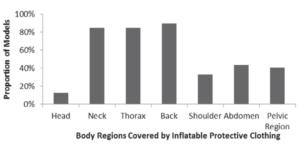EVU XXVII 2018 – 15 Injury Mitigation Potential of Inflatable Protective Motorcycle Jackets
Injury Mitigation Potential of Inflatable
Protective Motorcycle Jackets
Adam Barrow, Siobhan O’Connell, Phil Martin, David Hynd
Transport Research Laboratory Ltd, United Kingdom
Abstract
Inflatable protective motorcyclist jackets (“air jackets”) are a key innovation that has the potential to reduce the severity of injuries experienced by motorcyclists during collisions. Despite transfer of the technology from the motorsport industry, the relative benefits and disbenefits of these potentially life-saving technologies, in terms of e%ectiveness, reliability, cost and comfort, are currently unknown. Research literature and data from motorcycle collisions in the UK’s Road Accident In-Depth Studies (RAIDS) were analysed to understand the nature of the injuries sustained by motorcyclists. The thorax was often the most severely injured body region.
The head, abdomen, spine and pelvis were also frequently injured and often at a high severity. Injuries to the thorax were often the most prevalent serious (AIS 3+) and severe (AIS 4+) injury. At the AIS 3+ level, the thoracic region was often the most severely injured body region (when a single region dominated) or joint most severely injured body region. The specifications of 39 state-of-the-art air jacket models were evaluated and followed up by a review of literature to establish the e%ectiveness of air jackets for reducing the risks of injuries during falls and collisions. The majority of air jackets on the market do not have a guaranteed minimum level of protection. Only a quarter of air jacket models claimed to have deployment times that could protect riders during the majority of collisions and falls (<100 ms).
La lettura di questo articolo è riservata ai soli Soci EVU Italia.
| Autore | Adam Barrow, Siobhan O’Connell, Phil Martin, David Hynd Transport Research Laboratory Ltd, United Kingdom |
| Pubblicato il | |
| Tipologia |
